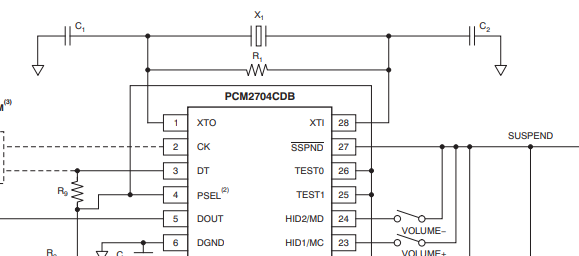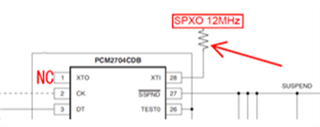Other Parts Discussed in Thread: PCM2706C,
Hi team,
Could you tell me how to connect the crystal oscillator?
Also, could you tell me how to calculate R1?
I think the crystal resonator was the only one in the datasheet.
Sincerely.
Kengo.
This thread has been locked.
If you have a related question, please click the "Ask a related question" button in the top right corner. The newly created question will be automatically linked to this question.
Hello Kengo, Usually the resistor R1 is a huge resistor ( typically a 1Mohm resistor) and it is connected in parallels to crystal osc. to XT1 and XT0 as shown below.
Regards,
Arash

Please read this part of the data sheet that explains what you need.
9.3 Feature Description
9.3.1 Clock and Reset
For both USB and audio functions, the PCM2704C/5C/6C/7C require a 12-MHz (±500 ppm) clock that can be generated by the onboard oscillator using a 12-MHz crystal resonator. The 12-MHz crystal resonator must be connected to the XTI pin (pin 28 for the PCM2704C/5C, pin 12 for the PCM2706C/7C) and the XTO pin (pin 1 for the PCM2704C/5C, pin 13 for the PCM2706C/7C) with one large (1-MΩ) resistor and two small capacitors; the capacitance of these components depends on the specified load capacitance of the crystal resonator. An external clock can be supplied from XTI (pin 28 for the PCM2704C/5C, pin 12 for the PCM2706C/7C). If an external clock is supplied, XTO (pin 1 for the PCM2704C/5C, pin 13 for the PCM2706C/7C) must be left open. No clock disabling pin is provided; therefore, TI does not recommend to use the external clock supply. SSPND (pin 27 for the PCM2704C/5C, pin 11 for the PCM2706C/7C) cannot use clock disabling. The PCM2704C/5C/6C/7C have an internal power-on reset circuit, which works automatically when VDD (pin 7 for the PCM2704C/5C, pin 21 for the PCM2706C/7C) exceeds 2-V typical (1.6 to 2.4 V), which is equivalent to VBUS (pin 10 for the PCM2704C/5C, pin 24 for the PCM2706C/7C) exceeding 3-V typical for bus-powered applications. Approximately 700 μs is required until an internal reset release occurs.
regards,
Arash
Hi Arash,
If I use an oscillator, can I make the following connections?
Oscillator: https://docs.rs-online.com/1da8/0900766b814e16db.pdf
And, could you tell me how to calculate this resistance value.
What resistance value do you recommend?
Sincerely.
Kengo.
Hi Kengo, I don't know the internal circuitry that is connected to XT0 and XT1 but I would not leave one pin NC and just use one pin. I have not seen it used they way you want, also I am not familiar with the clock oscillator that you want to use to make any suggestions to you.
Regards,
Arash
Hi Arash,
The oscillator has an oscillator circuit.
The resonator doesn't have an oscillator circuit.
So, PCM2704C has an oscillator circuit for resonator.
I want to use the osillator, so it does not need an oscillator circuit in PCM2704C.
Could you tell me how to connect an oscillator?
Sincerely.
Kengo.
Kengo, the functional diagram you showed here is a Pierce Oscillator. Even though an external clock can be supplied from XTI as you desired but no clock disabling pin is provided; therefore, TI does not recommend to use the external clock supply and leave the other pin NC. As i said I have not seen anybody use it in this fashion- probably for the above reason.
I have seen oscillators on some EVMs for XMOS and a 33 Ohm resistor was used . I do not know of any equation and may be the best is to contact the manufacturer of the oscillator you want to use and see if they have any recommendation to use with it.
Regards,
Arash